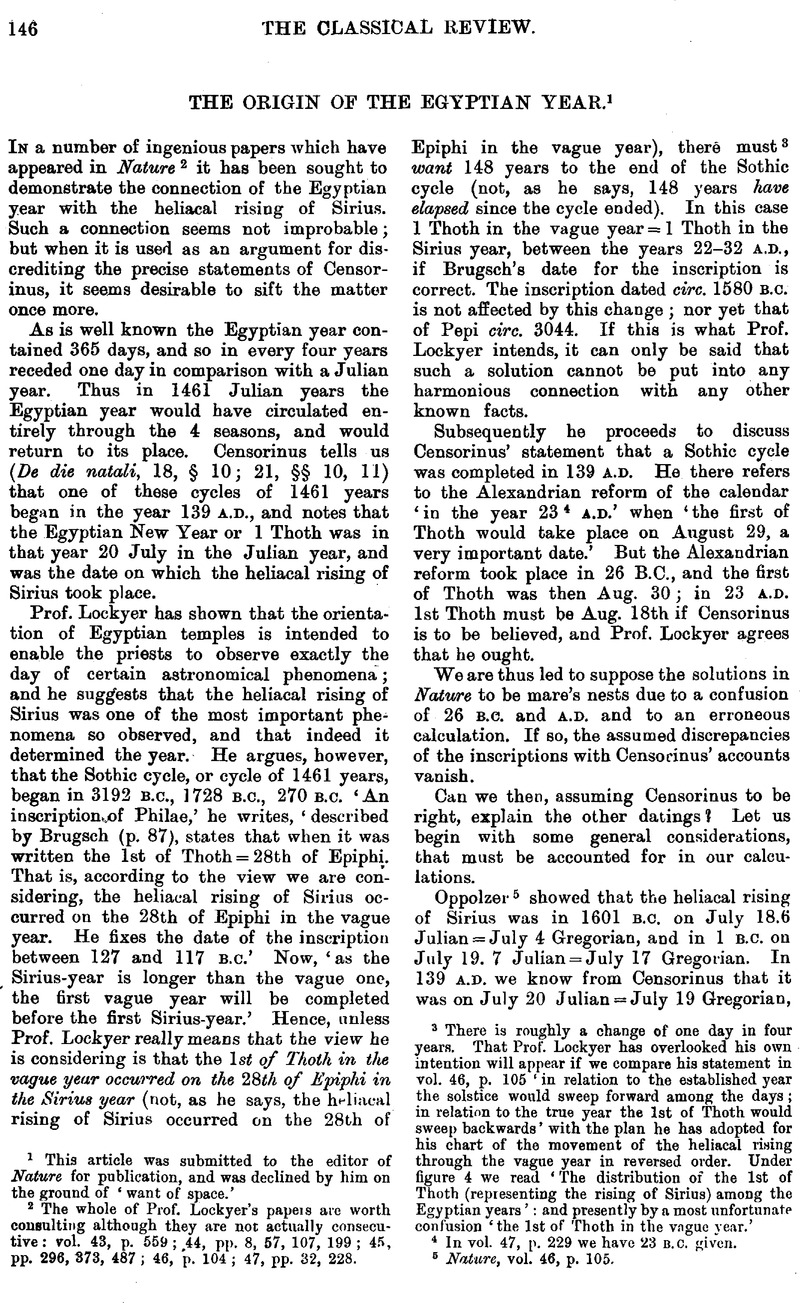No CrossRef data available.
Article contents
The Origin of the Egyptian Year1
Published online by Cambridge University Press: 27 October 2009
Abstract

- Type
- Original Contributions
- Information
- Copyright
- Copyright © The Classical Association 1900
References
page 146 note 2 The whole of Prof. Lockyer's papers are worth consulting although they are not actually consecutive: vol. 43, p. 559; 44, pp. 8, 57, 107, 199; 45, pp. 296, 373, 487 ; 46, p. 104 ; 47, pp. 32, 228.
page 146 note 3 There is roughly a change of one day in four years. That Prof. Lockyor has overlooked his own intention will appear if we compare his statement in vol. 46, p. 105 ‘in relation to the established year the solstice would sweep forward among the days; in relation to the true year the 1st of Thoth would sweep backwards’ with the plan he has adopted for his chart of the movement of the heliacal rising through the vague year in reversed order. Under figure 4 we read ‘The distribution of the 1st of Thoth (representing the rising of Sirius) among the Egyptian years’: and presently by a most unfortunate confusion ‘the 1st of Thoth in the vague year.’
page 146 note 4 In vol. 47, p. 229 we have 23 B.C. given.
page 146 note 6 Nature, vol. 46, p. 105.Google Scholar
page 147 note 1 These figures and the others throughout the rest of the paper, though only approximations, are almost certainly so accurate that no correction that may be necessary will invalidate the reasoning based upon them. In 139 A.D. the exact date would be 20.5 Julian.
page 147 note 2 I have left Prof. Lockyer's figures (Nature, vol. 46, p. 105Google Scholar), although 365.242193 is given by C. A. Young (General Astronomy, pp. 137, 528) as the length of the tropical year. This would make the length of the solstice cycle 1507 years, and a little over: so that two cycles would perhaps cover 3015 years. The first period would begin in 2877 or 2876 B.C.
page 147 note 3 If we use Oppolzer's figures as precise, and work rigorously so that Sirius in 1600 years rises later by ![]() days than would be given by a 365 day year, we get 1455.9 years, virtually 1456 as the length of the Sirius cycle. In such long periods of time a small error in the calculation of Sirius' rising and in the estimate of the length of the year becomes momentous. It may be suggested that the date 2876 B.C. should be used to correct the Sirius calculations with, and not vice versa. It should be noticed that in 2876 B.C. Sirius rose 17.9 Julian, and the solstice was July 17.3. Biot (Nature, vol. 46, p. 105Google Scholar) is obsolete.
days than would be given by a 365 day year, we get 1455.9 years, virtually 1456 as the length of the Sirius cycle. In such long periods of time a small error in the calculation of Sirius' rising and in the estimate of the length of the year becomes momentous. It may be suggested that the date 2876 B.C. should be used to correct the Sirius calculations with, and not vice versa. It should be noticed that in 2876 B.C. Sirius rose 17.9 Julian, and the solstice was July 17.3. Biot (Nature, vol. 46, p. 105Google Scholar) is obsolete.
page 147 note 4 Nature, vol. 47, p. 33.Google Scholar
page 147 note 5 Or reckoning accurately 113–109 B.C.
page 147 note 6 5 Epacts + 30 Mesori + 30 Epiphi + 30 Payni=95 And this must have 1 subtracted for the difference between July 19 and 20 Julian.
page 148 note 1 Nature, vol. 47, p. 230Google Scholar. It is noteworthy that Edfu and Philae, where the dates appear that yield 34 A.D. for the beginning of the cycle, are not remote from one another, and are roughly 300 miles south of Memphis. Cf. supra, p. 147 b
page 148 note 2 Perhaps more probably every 480 years or so. See Nature, vol. 47, p. 228.Google Scholar
page 148 note 3 Nature, vol. 47, p. 32.CrossRefGoogle Scholar




